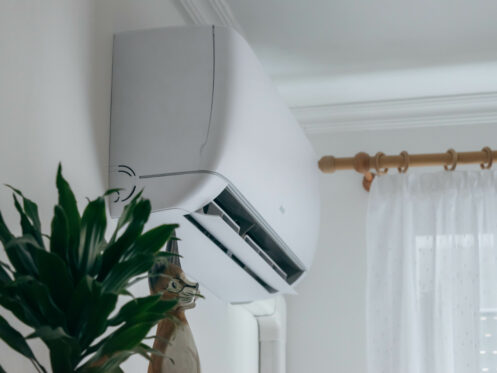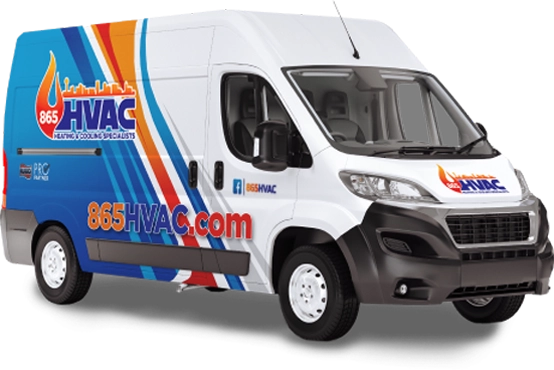All homeowners in Knoxville, TN, desire comfort and efficiency from their air conditioning systems. Traditionally, people have chosen central AC systems to cool their homes. However, over the last several years, interest in ductless mini-split systems has increased. If you’re in the market for a new air conditioning system, you might wonder: Which is the right system for me? The answer depends on various factors, such as upfront cost and installation requirements. At 865 HVAC, we know a one-size-fits-all solution doesn’t exist when it comes to choosing a cooling system. There’s much to consider, and it’s why we’re breaking everything down for you in this blog post.
Understanding Central Air Conditioning
Central air conditioning systems consist of a split system. This type of system has three components: an outdoor condenser/compressor, an indoor air handler, and an indoor evaporator coil. Central AC systems also rely on ductwork to distribute the conditioned air throughout the home.
One of the benefits of a central AC system is its ability to cool the entire home at once. It’s also a hidden system, meaning the entire system is tucked away and out of sight. The air handler is usually in the basement or a utility closet. The ductwork is unexposed, unless you live in a home with exposed ductwork like an industrial loft.
While central AC systems have many benefits, they fall short compared to ductless mini-split systems in the following ways.
- Installation costs
- Efficiency
- Zone control
- Required space
Houses with subpar ductwork or no existing ductwork in additions, garages, or attic spaces find installing a central AC system costs more upfront. The reason for the additional cost is duct installation.
The central AC unit relies on ductwork to move conditioned air throughout the house. Leaky or otherwise damaged ductwork can cause efficiency issues and cooled air loss.
Another drawback of traditional AC units is their need for space. Air handlers take up quite a bit of room. If you don’t have a basement or roomy utility closet, you’ll be giving up valuable space.
Understanding Ductless Mini-Split Systems
A ductless mini-split system includes an outdoor unit connected to multiple indoor air handlers using a conduit. This setup means no ductwork is required for the system to cool rooms (or individual zones) in your home.
Homeowners who value energy efficiency, zone control, and don’t want potential energy loss from leaky ductwork choose mini-split systems. Not relying on ductwork means more flexible installation and more cost-effective options for cooling renovated spaces, additions, and homes without existing ductwork. Mini-splits offer quiet operation and can even heat the home.
While mini-split systems have obvious benefits, they also have drawbacks. One of the drawbacks that turns off some homeowners is the visibility of the indoor units. Unlike a central AC system, mini-split indoor units are installed throughout the house. They are installed near the ceiling or, sometimes, near the floor, which can bother homeowners who want a specific aesthetic in their home. Additionally, mini-splits have a higher per-zone unit cost and aren’t always ideal for cooling large homes.
Direct Comparison: Key Factors
Purchasing a new AC system isn’t cheap. It’s not a decision to make lightly, nor do you have to choose the same type of system you’re replacing. When making such a large investment in your home, you want to do your research and understand the differences between the two types.
Initial Cost and Installation
Central AC systems almost always have a higher upfront cost for the full system and adjustments or additions to existing ductwork. Installing a central AC system is also labor-intensive, often taking a full day or more to complete. The labor costs can add up.
With a ductless system, the installation is easier because no ductwork is required. These systems come at a lower per-unit cost, but keep in mind that the cost can trend upward when you add multiple zones.
When comparing the initial purchase and installation costs, consider whether there’s existing ductwork. If you’re trying to cool an area of the home that doesn’t have ductwork, a mini-split system in that area might work better.
Energy Efficiency and Operating Costs
An energy-efficient system saves you money over the unit’s lifespan. A central AC system, even one with a high Seasonal Energy Efficiency Ratio (SEER) rating, isn’t nearly as efficient as a ductless system. Duct leakage plays a role in the difference, but so does whole-home cooling because you’re always going to cool unused rooms. With ductless systems, you don’t experience energy loss from ductwork. You also have precise zone control and can choose to only cool occupied rooms.
The most important thing to consider when deciding which system is right for you is the long-term savings. Most times, ductless systems come out the clear winner in terms of efficiency and operating costs.
Comfort and Control
While uniform temperature distribution throughout the house is something that people with central AC are used to, it’s not always the best option for staying comfortable in the home. Ductless systems offer excellent zone control by allowing different temperatures in different rooms. They’re also wonderful for rapidly cooling (and heating) specific areas in the home. Ductless systems also meet the varying comfort needs of multi-person households. Not everyone agrees that 68 or 73 degrees Fahrenheit is the perfect temperature for their bedroom. With a ductless system, every zone can have a different temperature. This feature alone saves money on energy bills and staves off arguments over the thermostat setting.
Maintenance & Lifespan
You also want to consider the maintenance and lifespan differences between the two systems. Central AC systems require regular filter changes, benefit greatly from professional tune-ups, and can last 15-20 years when well-maintained.
Ductless systems require filter cleaning and professional tune-ups as well. They have a similar lifespan to their central AC counterparts. However, the potentiality exists for a longer lifespan because there’s less stress on the individual units.
Which Is Right for You?
As we mentioned previously, a one-size-fits-all solution doesn’t exist. Homeowners need to choose for themselves what works best for their home, lifestyle, and budget. At 865 HVAC, we can help you decide, but here’s a quick cheatsheet to get you started.
Choose Central AC if the following factors are present.
- Ductwork is in good condition
- Desire uniform temperature throughout your entire house
- Want an “out-of-sight” system
- Building a new home and can design an efficient ductwork system
You may want to choose Ductless Mini-Splits if the below factors are true for you.
- Home has no ductwork
- Adding an extension, garage apartment, or converting an attic/basement.
- Value precise zone control
- Want better energy savings
- Desire a system that heats and cools
We Can Help
At 865 HVAC, we never take the importance of your individual circumstances lightly. We consider your budget, home size, existing infrastructure, and comfort priorities when recommending an AC system. Call us today to discuss your air conditioning installation, maintenance, and AC repair needs in Knoxville with one of our top-rated HVAC professionals.


